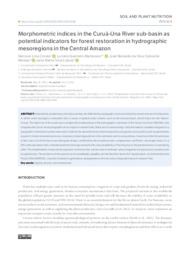Morphometric indices in the Curuá-Una River sub-basin as potential indicators for forest restoration in hydrographic mesoregions in the Central Amazon.
Morphometric indices in the Curuá-Una River sub-basin as potential indicators for forest restoration in hydrographic mesoregions in the Central Amazon.
Author(s): CORREA, D. L.; MARTORANO, L. G.; MORAES, J. R. da S. C. de; LISBOA, L. S. S.
Summary: Watersheds are planning units because they are delimited by topographic divisions formed by a main river and its tributaries, in which water drainage is channeled into a course of greater water volume, such as the Amazon basin, which flows into the Atlantic Ocean. The objective of this work was to analyze the morphometry of the hydrographic sub-basin of the Curuá-Una River (SBHRM), that integrates the Curuá-Una hydrographic micro-region in western Pará, Brazil, and its surroundings. Data from abiotic variables integrated in a geographic information system were used to identify the areas that most need restauration using production systems such as agroforestry as part of a forest restoration process, necessary to land degradation in the sub-basin and its surroundings. It was found that the sub-basin of the Curuá-Una River has a more elongated shape, confirmed by the circularity index, compactness coefficient, and shape factor. It is a fifth order sub-basin with a densely branched drainage network with a low probability of flooding due to the predominance of undulating relief. The morphometric characteristics present conditions that can be used in anthropic areas integrated into production systems such as agroforestry. The existence of tree species such as andiroba, copaíba, and the Brazil nut tree in the Tapajós basin, as inventoried by the Project RADAMBRAZIL, must be included in agroforestry arrangements in the recovery of degraded areas in western Pará.
Publication year: 2022
Types of publication: Journal article
Unit: Embrapa Eastern Amazon
Keywords: Amazonia, Erosão, Forest restoration, Restauração florestal
Observation
Some of Embrapa's publications are published as ePub files. To read them, use or download one of the following free software options to your computer or mobile device. Android: Google Play Books; IOS: iBooks; Windows and Linux: Calibre.
Access other publications
Access the Agricultural Research Database (BDPA) to consult Embrapa's full library collection and records.
Visit Embrapa Bookstore to purchase books and other publications sold by Embrapa.

